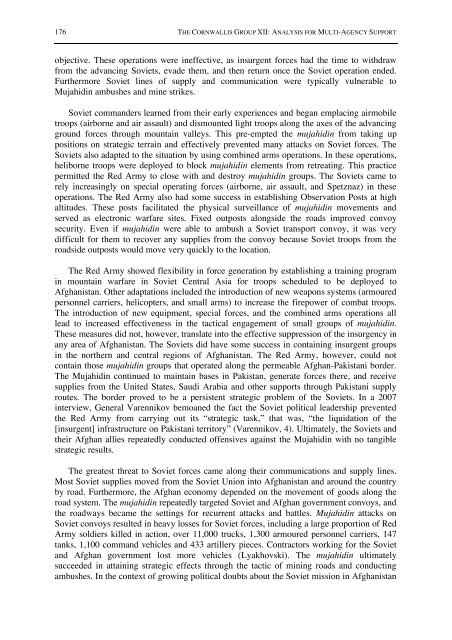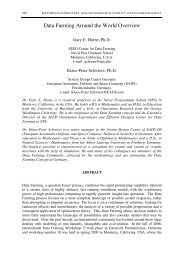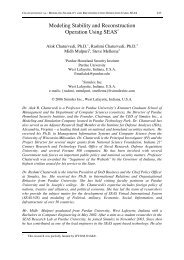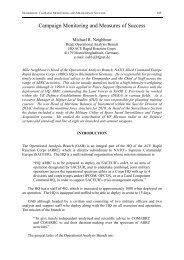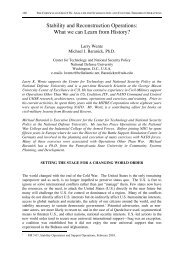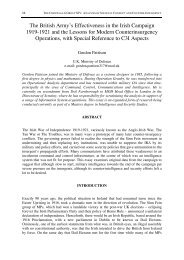Lessons Learned from the Soviet Experience in ... - Cornwallis Group
Lessons Learned from the Soviet Experience in ... - Cornwallis Group
Lessons Learned from the Soviet Experience in ... - Cornwallis Group
You also want an ePaper? Increase the reach of your titles
YUMPU automatically turns print PDFs into web optimized ePapers that Google loves.
176 THE CORNWALLIS GROUP XII: ANALYSIS FOR MULTI-AGENCY SUPPORTobjective. These operations were <strong>in</strong>effective, as <strong>in</strong>surgent forces had <strong>the</strong> time to withdraw<strong>from</strong> <strong>the</strong> advanc<strong>in</strong>g <strong>Soviet</strong>s, evade <strong>the</strong>m, and <strong>the</strong>n return once <strong>the</strong> <strong>Soviet</strong> operation ended.Fur<strong>the</strong>rmore <strong>Soviet</strong> l<strong>in</strong>es of supply and communication were typically vulnerable toMujahid<strong>in</strong> ambushes and m<strong>in</strong>e strikes.<strong>Soviet</strong> commanders learned <strong>from</strong> <strong>the</strong>ir early experiences and began emplac<strong>in</strong>g airmobiletroops (airborne and air assault) and dismounted light troops along <strong>the</strong> axes of <strong>the</strong> advanc<strong>in</strong>gground forces through mounta<strong>in</strong> valleys. This pre-empted <strong>the</strong> mujahid<strong>in</strong> <strong>from</strong> tak<strong>in</strong>g uppositions on strategic terra<strong>in</strong> and effectively prevented many attacks on <strong>Soviet</strong> forces. The<strong>Soviet</strong>s also adapted to <strong>the</strong> situation by us<strong>in</strong>g comb<strong>in</strong>ed arms operations. In <strong>the</strong>se operations,heliborne troops were deployed to block mujahid<strong>in</strong> elements <strong>from</strong> retreat<strong>in</strong>g. This practicepermitted <strong>the</strong> Red Army to close with and destroy mujahid<strong>in</strong> groups. The <strong>Soviet</strong>s came torely <strong>in</strong>creas<strong>in</strong>gly on special operat<strong>in</strong>g forces (airborne, air assault, and Spetznaz) <strong>in</strong> <strong>the</strong>seoperations. The Red Army also had some success <strong>in</strong> establish<strong>in</strong>g Observation Posts at highaltitudes. These posts facilitated <strong>the</strong> physical surveillance of mujahid<strong>in</strong> movements andserved as electronic warfare sites. Fixed outposts alongside <strong>the</strong> roads improved convoysecurity. Even if mujahid<strong>in</strong> were able to ambush a <strong>Soviet</strong> transport convoy, it was verydifficult for <strong>the</strong>m to recover any supplies <strong>from</strong> <strong>the</strong> convoy because <strong>Soviet</strong> troops <strong>from</strong> <strong>the</strong>roadside outposts would move very quickly to <strong>the</strong> location.The Red Army showed flexibility <strong>in</strong> force generation by establish<strong>in</strong>g a tra<strong>in</strong><strong>in</strong>g program<strong>in</strong> mounta<strong>in</strong> warfare <strong>in</strong> <strong>Soviet</strong> Central Asia for troops scheduled to be deployed toAfghanistan. O<strong>the</strong>r adaptations <strong>in</strong>cluded <strong>the</strong> <strong>in</strong>troduction of new weapons systems (armouredpersonnel carriers, helicopters, and small arms) to <strong>in</strong>crease <strong>the</strong> firepower of combat troops.The <strong>in</strong>troduction of new equipment, special forces, and <strong>the</strong> comb<strong>in</strong>ed arms operations alllead to <strong>in</strong>creased effectiveness <strong>in</strong> <strong>the</strong> tactical engagement of small groups of mujahid<strong>in</strong>.These measures did not, however, translate <strong>in</strong>to <strong>the</strong> effective suppression of <strong>the</strong> <strong>in</strong>surgency <strong>in</strong>any area of Afghanistan. The <strong>Soviet</strong>s did have some success <strong>in</strong> conta<strong>in</strong><strong>in</strong>g <strong>in</strong>surgent groups<strong>in</strong> <strong>the</strong> nor<strong>the</strong>rn and central regions of Afghanistan. The Red Army, however, could notconta<strong>in</strong> those mujahid<strong>in</strong> groups that operated along <strong>the</strong> permeable Afghan-Pakistani border.The Mujahid<strong>in</strong> cont<strong>in</strong>ued to ma<strong>in</strong>ta<strong>in</strong> bases <strong>in</strong> Pakistan, generate forces <strong>the</strong>re, and receivesupplies <strong>from</strong> <strong>the</strong> United States, Saudi Arabia and o<strong>the</strong>r supports through Pakistani supplyroutes. The border proved to be a persistent strategic problem of <strong>the</strong> <strong>Soviet</strong>s. In a 2007<strong>in</strong>terview, General Varennikov bemoaned <strong>the</strong> fact <strong>the</strong> <strong>Soviet</strong> political leadership prevented<strong>the</strong> Red Army <strong>from</strong> carry<strong>in</strong>g out its “strategic task,” that was, “<strong>the</strong> liquidation of <strong>the</strong>[<strong>in</strong>surgent] <strong>in</strong>frastructure on Pakistani territory” (Varennikov, 4). Ultimately, <strong>the</strong> <strong>Soviet</strong>s and<strong>the</strong>ir Afghan allies repeatedly conducted offensives aga<strong>in</strong>st <strong>the</strong> Mujahid<strong>in</strong> with no tangiblestrategic results.The greatest threat to <strong>Soviet</strong> forces came along <strong>the</strong>ir communications and supply l<strong>in</strong>es.Most <strong>Soviet</strong> supplies moved <strong>from</strong> <strong>the</strong> <strong>Soviet</strong> Union <strong>in</strong>to Afghanistan and around <strong>the</strong> countryby road. Fur<strong>the</strong>rmore, <strong>the</strong> Afghan economy depended on <strong>the</strong> movement of goods along <strong>the</strong>road system. The mujahid<strong>in</strong> repeatedly targeted <strong>Soviet</strong> and Afghan government convoys, and<strong>the</strong> roadways became <strong>the</strong> sett<strong>in</strong>gs for recurrent attacks and battles. Mujahid<strong>in</strong> attacks on<strong>Soviet</strong> convoys resulted <strong>in</strong> heavy losses for <strong>Soviet</strong> forces, <strong>in</strong>clud<strong>in</strong>g a large proportion of RedArmy soldiers killed <strong>in</strong> action, over 11,000 trucks, 1,300 armoured personnel carriers, 147tanks, 1,100 command vehicles and 433 artillery pieces. Contractors work<strong>in</strong>g for <strong>the</strong> <strong>Soviet</strong>and Afghan government lost more vehicles (Lyakhovski). The mujahid<strong>in</strong> ultimatelysucceeded <strong>in</strong> atta<strong>in</strong><strong>in</strong>g strategic effects through <strong>the</strong> tactic of m<strong>in</strong><strong>in</strong>g roads and conduct<strong>in</strong>gambushes. In <strong>the</strong> context of grow<strong>in</strong>g political doubts about <strong>the</strong> <strong>Soviet</strong> mission <strong>in</strong> Afghanistan


